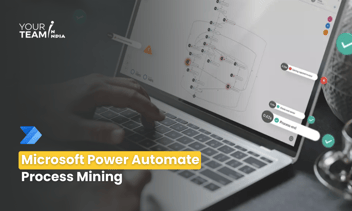Quick Summary: Discover how integrating process mining and task mining in Power Automate can enhance process automation. This article explores the benefits, methodologies, and practical applications of these technologies, providing insights into optimizing workflows and improving efficiency in automated processes.
Abstract
Process automation has become integral to modern businesses, streamlining workflows and enhancing efficiency. Microsoft Power Automate, a powerful automation tool, offers capabilities beyond basic automation through the incorporation of process mining and task mining. This article delves into the concepts of process mining and task mining and their integration within Power Automate. It explores their functionalities, benefits, and practical applications, providing a comprehensive understanding of how these features can revolutionize automation strategies.
Introduction
In the digital transformation landscape, organizations seek ways to optimize their processes for improved productivity and reduced operational costs. Microsoft Power Automate emerges as a versatile solution that empowers users to automate tasks across various applications and services. The integration of process mining and task mining further elevates its capabilities, allowing for a deeper understanding of processes and behaviors within workflows.
Ready to supercharge your business processes with Power Automate?
Hire our skilled Power Automate developers to automate workflows and boost efficiency.
Understanding Process Mining
Process mining involves the analysis of event logs to derive insights into business processes. Within Power Automate, process mining enables users to visualize, analyze, and optimize their workflows by leveraging historical data. This section will cover the fundamental concepts of process mining, including:
- Event logs and their significance
- Process discovery and visualization
- Process performance analysis
- Identification of bottlenecks and inefficiencies
Understanding Task Mining
Task mining focuses on capturing user interactions with applications and systems to comprehend task sequences, user behaviors, and variations in processes. Power Automate's task mining capabilities allow for real-time tracking and analysis of user interactions. This section will elaborate on task mining by addressing:
- Data capture techniques (screen recording, user interactions)
- Process insights derived from task mining
- Real-time monitoring and analysis
- Utilizing task insights for process improvement
When to use Process Mining
- See the actual steps needed to perform your organization’s operation process and remove any guesswork.
- Save time and money by optimizing processes.
- Detect noncompliant processes and/or tasks.
- Discover automation opportunities.
- Compare processes.
- Find mistakes.
- Understand where and why problems occur.
When to use Task Mining
- Understand what employees actually do while performing each task on their desktops.
- Identify and eliminate unnecessary actions in-process tasks.
- Identify the most common actions through user interactions.
- Ensure compliance and perform audits.
- Automate tasks that would accelerate processes and reduce human errors.
How to use Process And Task Mining in Power Automate
You can create a new process with task mining or process mining by clicking on the process mining icon on the left pane in Power Automate.
You can either choose Process mining or Task mining and give it a name by creating a new process.
You can either create a process with the recording or import data that needs to be imported into the power automation.
After performing all the steps, you will get a graphical map of the steps and their frequencies with their scores, which you can analyze.
Creating Automation Workflows based on Mined Data
Once correlated insights are obtained, Power Automate allows users to create automation workflows directly from the mined data. It provides a visual interface where users can drag and drop elements to construct automated sequences based on the observed processes and user interactions. For example, if a task mining analysis identifies repetitive manual data entry tasks in a process, Power Automate enables the creation of automated workflows to handle this task, reducing errors and improving efficiency.
The tool’s user-friendly interface simplifies the process of transforming mined insights into actionable automation. Additionally, it allows for the integration of different applications or services involved in the workflow, ensuring seamless end-to-end automation.
Continuous Improvement through Feedback Loops
Power Automate's integration of process and task mining fosters a culture of continuous improvement. It establishes feedback loops by capturing real-time data on process performance and user interactions. These loops enable iterative enhancements to automation workflows based on ongoing analysis and feedback.
The system can detect anomalies or changes in user behavior, triggering alerts or notifications for further investigation. Organizations can leverage this feedback to adapt workflows, address emerging issues, and continuously optimize processes.
Benefits of Leveraging Process and Task Mining in Power Automate
Enhanced Process Transparency and Visibility:
Integrating process mining and task mining in Power Automate provides organizations with a bird’s-eye view of their workflows. It offers transparency by visualizing the entire end-to-end process, highlighting each step and interaction involved. This transparency allows stakeholders to comprehend complex processes and identify areas for improvement more effectively.
With clear visualizations derived from process mining, stakeholders can gain insights into process variations, exceptions, and deviations from the standard workflow. Task mining adds granular visibility by showcasing user interactions within each step, facilitating a comprehensive understanding of how tasks are executed in real time. The result is a complete, transparent view of processes, enabling better decision-making and targeted optimization efforts.
Improved Process Efficiency and Optimization:
By analyzing historical process data and real-time user interactions, Power Automate's mining capabilities enable the identification of workflow inefficiencies and bottlenecks. This understanding lays the groundwork for process optimization initiatives.
Process mining reveals areas where processes can be streamlined, helping to eliminate redundant steps or automate repetitive tasks. Task mining pinpoints manual interventions or areas prone to delays, guiding automation efforts for enhanced efficiency. Organizations can redesign workflows based on these insights, resulting in smoother, faster, and more efficient processes.
Identification and Mitigation of Compliance Risks:
Compliance with regulations and internal policies is critical for organizations across industries. Process and task mining in Power Automate contribute significantly to compliance management.
Process mining helps in detecting deviations from prescribed procedures, enabling organizations to ensure adherence to compliance standards. Task mining identifies patterns of behavior that may pose compliance risks, such as unauthorized access or non-compliant actions. By pinpointing these issues, organizations can proactively address compliance risks, implement necessary controls, and prevent potential regulatory violations.
Empowering Data-Driven Decision-Making:
One of the most significant advantages of leveraging process and task mining in Power Automate is the empowerment of data-driven decision-making. These mining capabilities generate valuable data and insights that serve as the foundation for informed decision-making.
By relying on data rather than assumptions, organizations can make strategic decisions backed by evidence. They can measure the impact of process changes, evaluate the success of automation initiatives, and allocate resources more effectively based on quantifiable metrics derived from mining insights.
Challenges and Considerations:
While process and task mining offer substantial benefits, there are challenges and considerations to address. This section will discuss:
- Data privacy and security concerns
- Ensuring the accuracy and reliability of mined data
- Change management and adoption hurdles
- Integrating mining capabilities with existing systems and workflows
Conclusion:
The integration of process mining and task mining within Microsoft Power Automate marks a significant leap in the realm of process automation. By harnessing historical data and real-time user interactions, organizations can gain invaluable insights, optimize processes, and drive operational excellence. Embracing these capabilities opens doors to enhanced efficiency, agility, and competitiveness in today's dynamic business landscape.
Hire Power Automate developers to automate workflows, boost efficiency, and unlock your organization's full potential. Let's transform your operations together!








